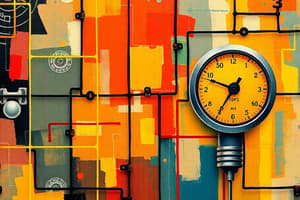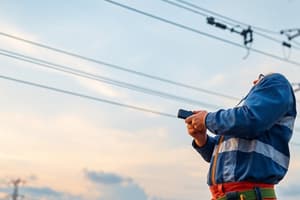Podcast
Questions and Answers
A Class 2 electrician typically operates under the supervision of which of the following?
A Class 2 electrician typically operates under the supervision of which of the following?
- An electrical engineer
- A master electrician
- A project manager
- A Class 1 electrician (correct)
Electrical work can be performed without adhering to local and national electrical codes if a qualified electrician deems it safe.
Electrical work can be performed without adhering to local and national electrical codes if a qualified electrician deems it safe.
False (B)
According to Ohm's Law, Voltage (V) is equal to Current (I) multiplied by ______.
According to Ohm's Law, Voltage (V) is equal to Current (I) multiplied by ______.
Resistance
Which of the following wiring methods is commonly used for providing a protective enclosure for electrical conductors?
Which of the following wiring methods is commonly used for providing a protective enclosure for electrical conductors?
Why is grounding and bonding of electrical systems important?
Why is grounding and bonding of electrical systems important?
Which type of electrical diagram is most suitable for quickly tracing the path of a circuit from source to load?
Which type of electrical diagram is most suitable for quickly tracing the path of a circuit from source to load?
Match the electrical component with its primary function:
Match the electrical component with its primary function:
During electrical testing, what parameter is a multimeter set to measure when verifying the continuity of a circuit?
During electrical testing, what parameter is a multimeter set to measure when verifying the continuity of a circuit?
Which of the following tests is most suited to identify degradation within cable insulation?
Which of the following tests is most suited to identify degradation within cable insulation?
Lockout/tagout procedures are optional when de-energizing circuits for short maintenance tasks.
Lockout/tagout procedures are optional when de-energizing circuits for short maintenance tasks.
What is the primary function of a Ground Fault Circuit Interrupter (GFCI)?
What is the primary function of a Ground Fault Circuit Interrupter (GFCI)?
A motor ______ is used to start and stop an electric motor, while also providing overload protection.
A motor ______ is used to start and stop an electric motor, while also providing overload protection.
Match the transformer type to its primary application:
Match the transformer type to its primary application:
Which of the following is the MOST important first aid step for an electrical shock victim?
Which of the following is the MOST important first aid step for an electrical shock victim?
Variable Frequency Drives (VFDs) are used to control the speed of AC motors.
Variable Frequency Drives (VFDs) are used to control the speed of AC motors.
What type of personal protective equipment should be worn when there is a risk of arc flash?
What type of personal protective equipment should be worn when there is a risk of arc flash?
Staying up-to-date with the latest revisions to electrical ______ and ______ is crucial for safe and compliant electrical work.
Staying up-to-date with the latest revisions to electrical ______ and ______ is crucial for safe and compliant electrical work.
A Class 2 electrician is performing a task that requires direct supervision by a Class 1 electrician. Which of the following describes the MOST important reason for this requirement?
A Class 2 electrician is performing a task that requires direct supervision by a Class 1 electrician. Which of the following describes the MOST important reason for this requirement?
Flashcards
Class 2 Electrician
Class 2 Electrician
An electrician qualified to perform a limited scope of electrical work, typically under supervision.
Electrical Codes/Regulations
Electrical Codes/Regulations
Rules and guidelines that ensure electrical work is safe and up to standard.
Ohm's Law & Power Formula
Ohm's Law & Power Formula
Voltage (V) = Current (I) x Resistance (R); Power (P) = Voltage (V) x Current (I).
Wiring Methods
Wiring Methods
Signup and view all the flashcards
Electrical Installations
Electrical Installations
Signup and view all the flashcards
Electrical Drawings
Electrical Drawings
Signup and view all the flashcards
Electrical Measurement
Electrical Measurement
Signup and view all the flashcards
Single-Line Diagram
Single-Line Diagram
Signup and view all the flashcards
Insulation Resistance Testing
Insulation Resistance Testing
Signup and view all the flashcards
Continuity Testing
Continuity Testing
Signup and view all the flashcards
Ground Resistance Testing
Ground Resistance Testing
Signup and view all the flashcards
Fault Finding
Fault Finding
Signup and view all the flashcards
Electrical Safety Practices
Electrical Safety Practices
Signup and view all the flashcards
Circuit Breakers
Circuit Breakers
Signup and view all the flashcards
Ground Fault Circuit Interrupters (GFCIs)
Ground Fault Circuit Interrupters (GFCIs)
Signup and view all the flashcards
Effective Communication
Effective Communication
Signup and view all the flashcards
Class 2 Electrician Scope
Class 2 Electrician Scope
Signup and view all the flashcards
Lockout/Tagout
Lockout/Tagout
Signup and view all the flashcards
Study Notes
Trade Test Class 2 Electrical
- A Class 2 electrician works under a Class 1 electrician's supervision.
- Class 2 scope of work is more limited than that of Class 1 electricians.
- Essential knowledge includes electrical theory, regulations, and safety.
- Wiring, installations, and fault finding require practical skills.
- Electrical drawings and diagrams must be understood.
Regulations and Standards
- Compliance with local and national electrical codes is a must.
- The National Electrical Code (NEC) is used in the United States.
- Wiring methods, overcurrent protection, and grounding are regulated.
- Compliance with safety standards prevents electrical hazards.
Electrical Theory
- Voltage, current, resistance, and power are fundamental concepts (V=IR, P=VI).
- It is necessary to understand AC and DC circuits.
- Series, parallel, and series-parallel circuits should be known.
- Calculating voltage drops, current flow, and power dissipation is essential.
- You should understand resistors, capacitors, inductors, transformers, and diodes.
Wiring Methods
- Selection and installation of cables and conductors must be done correctly
- Conduit, cable tray, and direct burial are examples of wiring methods.
- Correct termination and connection techniques ensure safety and reliability.
- Cable sizing and derating factors must be understood.
Electrical Installations
- Lighting fixtures, receptacles, and switches should be installed.
- Electrical panels and distribution boards should be wired.
- Motors, transformers, and equipment should be installed.
- Electrical systems must be grounded and bonded for safety.
- Wiring techniques must be correct for different equipment and applications.
Electrical Drawings and Diagrams
- Electrical drawings like single-line, wiring, and schematic diagrams should be read.
- Electrical symbols and notations should be understood.
- Drawings are used to locate components and circuits.
- Electrical systems should be installed and troubleshooted using drawings.
Testing and Measurement
- Multimeters are used to measure voltage, current, and resistance.
- Cables and equipment are tested for insulation breakdown.
- Circuit and connection integrity is verified.
- Grounding of electrical systems is tested.
- Specialized equipment is used for motor or power quality analysis.
Fault Finding and Troubleshooting
- Electrical faults are diagnosed using systematic methods.
- Common issues include short circuits, open circuits, and ground faults.
- Testing equipment locates faults in circuits and equipment.
- Faulty components and wiring are repaired or replaced.
- Electrical hazards are avoided by following safety procedures.
Safety Practices
- De-energize when working on circuits.
- Use PPE such as gloves, safety glasses, and insulated tools.
- Lockout/tagout prevents accidental energization.
- Be aware of arc flash and electrocution risks.
- Follow safe work practices near live equipment.
- Know first aid for electrical shock.
Motors and Control Circuits
- AC and DC motors' operational principles should be understood.
- Motor starters, contactors, and overload relays must be known.
- Motor control circuits should be wired and troubleshooted.
- Motor protection methods must be known.
- Variable frequency drives (VFDs) and their uses should be understood.
Transformers
- Transformer principles of operation must be understood.
- Types of transformers should be identified such as step-up, step-down, and isolation
- Transformers are connected in single-phase and three-phase.
- Transformer testing and maintenance is performed.
Protection Devices
- Circuit breakers, fuses, and GFCIs should be understood.
- Protection devices should be selected for circuits and equipment.
- Protection devices should be tested to ensure operation.
Lighting Systems
- Lighting fixtures, including incandescent, fluorescent, and LED should be installed and maintained.
- Lighting control systems like dimmers and occupancy sensors should be understood.
- Lighting levels should be calculated and appropriate lighting selected.
Communication and Interpersonal Skills
- Communication must be effective with supervisors, coworkers, and clients.
- Instructions should be followed and you should work as part of a team
- Conduct must be professional and ethical.
Specific Tasks
- Cables should be installed and terminated in electrical panels.
- Lighting fixtures and receptacles should be installed.
- Equipment should be wired and connected.
- Electrical faults should be troubleshooted.
- Preventive maintenance should be performed on systems.
- Safety procedures must be followed.
Tools and Equipment
- Hand tools such as pliers, screwdrivers, wire strippers, and crimpers should be known.
- Power tools such as drills, saws, and conduit benders should be used.
- Testing equipment such as multimeters, insulation testers, and ground resistance testers should be operated.
Knowledge of Materials
- Types of wires, cables, and conduits should be identified
- Properties and applications of electrical materials must be understood.
- Appropriate materials should be selected for installations.
Codes and Standards Updates
- Codes and standards revisions should be followed
- How code changes affect work practices should be understood.
Emergency Procedures
- Emergency procedures should be known for electrical accidents or fires.
- First aid techniques should be known for shock victims.
- Systems should be shut down in emergencies.
Renewable Energy
- Renewable energy systems like solar PV and wind should be understood.
- Solar panels and wind turbines should be installed and maintained (basic).
- Renewable energy systems should be connected to the grid (basic).
Automation and Control Systems
- Automation and control systems should be understood in buildings.
- Programmable logic controllers (PLCs), sensors, and actuators should be known (basic).
- Control circuits should be wired and troubleshooted.
Class 2 Electrician Scope
- Class 2 license limitations should be understood, especially supervision.
- Tasks needing Class 1 electrician supervision should be known
- When work exceeds the license scope must be recognized.
Studying That Suits You
Use AI to generate personalized quizzes and flashcards to suit your learning preferences.
Description
Covers the scope, regulations, and theory for Class 2 electricians. It emphasizes compliance with electrical codes, safety standards, and understanding fundamental concepts like voltage, current, resistance, and power. Practical skills and knowledge of electrical drawings are crucial.




